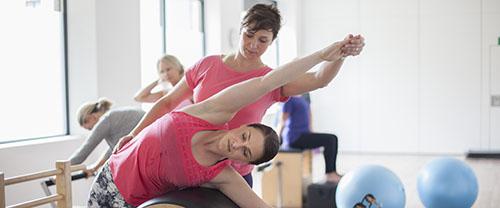5 Effective Low Impact Workouts

Want to turn back the hands of time? Try exercising.
Whether you’re entering your 50s or already retired, exercise can make a huge difference in how you feel and move. But selecting the right activities can make all the difference in terms of results and motivation. For example, low-impact workouts can help you stay fit or get fit as you age, while limiting the pain and damage that higher intensity exercises can cause. If you have arthritis or lingering injuries or haven’t worked out in a while, low-impact workouts help you get moving and stay moving.
Here are five low-impact cardio and resistance training exercises that are weight bearing and incorporate balance and flexibility training — great moves for aging exercisers. Be sure to discuss them with your doctor before starting.
Cycling strengthens the musculoskeletal and cardiovascular systems, improves joint mobility, eases stress and burns calories — all while being low impact. You can ride a stationary bike, go for a ride outside or, for a real challenge, take a cycling class.
Cycling can be solitary activity — a time to decompress and relax. It can also be social; grab a friend and go for a ride. And if you like indoor recumbent bikes, you can get caught up on news, social media, emails and texts while riding. Have a competitive spirit? Train for a cycling road race.
You’ll also burn hundreds of calories an hour (typically between 400 and 700) spinning.
Pilates is a mat and equipment movement system developed by Joseph Pilates. Despite the thousands of die-hard Pilates fitness enthusiasts, it’s actually rooted in therapeutic exercise, making it an effective workout for all ages, fitness levels and injury histories.
Pilates can help you develop a strong core, improving balance, overall stability and posture, as well as reducing back pain and fall risk. It’s downside? It’s not bone-building, so you’ll have to supplement it with walking or hiking. Don’t try teaching Pilates to yourself. Find a studio with small classes to learn the exercises with proper form and how to modify exercises for your specific injuries.
You’ll also burn between 175 and 250 calories per session, depending on intensity.
Strength training obviously strengthens your musculoskeletal system, but it also improves cardiovascular endurance, bone density and daily metabolic rate. Like cycling, you have a few options.
Weight training probably comes to mind first. If you’re new to weight training or just a little rusty, the machines at your local YMCA or gym are your safest bet. Once proficient, you can try cable machines or free weights.
You also need a warmup and cooldown with stretches to complete your workout. Work with a trainer before beginning a weightlifting program. They’ll help you figure out the best exercises for your skill and age.
Don’t’ see yourself as a gym rat? Try a group resistance exercise class that incorporates props such as bands, balls or circles and/or body weight exercises like pushups, planks and squats.
You’ll burn around 100 calories every half hour of resistance training (depending on your physical make up and the intensity of the workout).
Swimming works your entire body and builds cardiovascular endurance and muscular strength without impacting your joints. If you swam as a child, getting started may simply involve finding a pool. But if you never learned to swim or feel you need to brush up on your skills, most local swim schools and YMCAs offer adult swim classes.
If you like the water but aren’t thrilled with getting your face or hair wet, consider water aerobics. Like swimming, these fun classes work your entire body without putting much pressure on your joints. Facilities with pools such as fitness centers, YMCAs and community centers offer classes.
Like cycling, swimming is a great way to burn calories — around 400 to 500 an hour. That’s also true of water aerobics.
Tai chi is arguably one of the best forms of exercise for people over 50. This Chinese martial art is often described as “meditation in motion.” Studies suggest tai chi’s standing movement combinations may reduce stress and improve coordination, bone density, balance, muscle strength, flexibility and aerobic conditioning. To get going, sign up for classes or hire a private trainer. Learn the exercises and understand your alignment before trying home workouts. You’ll burn between 200 and 300 calories per hour of tai chi.
Yoga is another effective workout. It’s easy on your joints and helps improve strength, balance, coordination and bone density. There are eight major styles of yoga. Some styles provide a rigorous workout, while others focus on teaching proper alignment or restoring the nervous system.
Figure out your goals and explore classes that can help you. Like Pilates and Tai Chi, you’ll want to learn yoga first before trying home workouts.
If you have spinal issues such as herniated discs, stenosis, osteoporosis or arthritis, you’ll probably have to modify or maybe even skip certain yoga poses to avoid pain and injury. Forward flexion poses such as downward-facing dog, big toe pose and child’s pose can exacerbate herniations; extension poses like sphinx, cobra and cow poses are problematic for stenosis. And postures that work the spine beyond its limits of flexion and extension raise the risk of bone fractures in osteoporotic people, according to a study published in Mayo Clinic Proceedings.
Before beginning or changing your workout routine, talk to your doctor. Don’t have a physician? Consider partnering with an MDVIP-affiliated physician. MDVIP doctors have the time to help you develop a safe and effective workout. Find a physician near you and begin your partnership in health »


